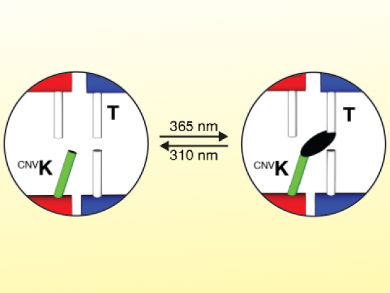DNA molecules can be used to build nanoscale 3D building blocks that click together like toy construction blocks if they are functionalized with shape-complementary surfaces. This approach allows the self-assembly of high-order objects that are held together by “sticky” non-covalent interactions between the blunt ends of DNA double helices. However, these high-order objects disintegrate in low-salt solutions, which limits the range of conditions under which such structures can be used.
Thomas Gerling and Hendrik Dietz, Technical University of Munich, Germany, have developed a site-specific and reversible photochemical method that allows “sticky” sites of DNA to be connected covalently. The researchers modified the blunt ends of DNA double helices with 3-cyanovinylcarbazole (cnvK) and thymine (T). Illumination with light at 365 nm formed a covalent bond between the two chemical groups (pictured right).
The bond-stabilized objects are stable even in buffers of low ionic strength. The covalent bonds across stacking contacts can be split by exposure to 310 nm light. The method improves the stability of high-order objects and could be used to prepare pure and dense solutions of higher order DNA complexes for use in in vitro and in vivo applications.
- Reversible Covalent Stabilization of Stacking Contacts in DNA Assemblies,
Thomas Gerling, Hendrik Dietz,
Angew. Chem. Int. Ed. 2019.
https://doi.org/10.1002/anie.201812463




